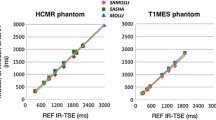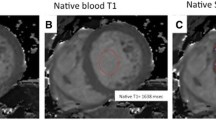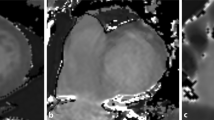Abstract
Objective
Our aim was to study the influence of small variations in spatial resolution and contrast agent dosage on myocardial T1 relaxation time.
Materials and methods
Twenty-nine healthy volunteers underwent cardiovascular magnetic resonance at 3T twice, including a modified look-locker inversion recovery (MOLLI) technique—3(3)3(3)5—for T1 mapping. Native T1 was assessed in three spatial resolutions (voxel size 1.4 × 1.4 × 6, 1.6 × 1.6 × 6, 1.7 × 1.7 × 6 mm3), and postcontrast T1 after 0.1 and 0.2 mmol/kg gadobutrol. Partition coefficient was calculated based on myocardial and blood T1. T1 analysis was done per segment, per slice, and for the whole heart.
Results
Native T1 values did not differ with varying spatial resolution per segment (p = 0.116–0.980), per slice (basal: p = 0.772; middle: p = 0.639; apex: p = 0.276), and globally (p = 0.191). Postcontrast T1 values were significantly lower with higher contrast agent dosage (p < 0.001). The global partition coefficient was 0.43 ± 0.3 for 0.2 and 0.1 mmol gadobutrol (p = 0.079).
Conclusion
Related to the tested MOLLI technique at 3T, very small variations in spatial resolution (voxel sizes between 1.4 × 1.4 × 6 and 1.7 × 1.7 × 6 mm3) remained without effect on the native T1 relaxation times. Postcontrast T1 values were naturally shorter with higher contrast agent dosage while the partition coefficient remained constant. Further studies are necessary to test whether these conclusions hold true for larger matrix sizes and in larger cohorts.


Similar content being viewed by others
References
Moon JC, Messroghli DR, Kellman P, Piechnik SK, Robson MD, Ugander M, Gatehouse PD, Arai AE, Friedrich MG, Neubauer S, Schulz-Menger J, Schelbert EB (2013) Myocardial T1 mapping and extracellular volume quantification: a Society for Cardiovascular Magnetic Resonance (SCMR) and CMR Working Group of the European Society of Cardiology consensus statement. J Cardiovasc Magn Reson 15:92
Dabir D, Child N, Kalra A, Rogers T, Gebker R, Jabbour A, Plein S, Yu CY, Otton J, Kidambi A, McDiarmid A, Broadbent D, Higgins DM, Schnackenburg B, Foote L, Cummins C, Nagel E, Puntmann VO (2014) Reference values for healthy human myocardium using a T1 mapping methodology: results from the International T1 Multicenter cardiovascular magnetic resonance study. J Cardiovasc Magn Reson 16:69
Kawel N, Nacif M, Zavodni A, Jones J, Liu S, Sibley CT, Bluemke DA (2012) T1 mapping of the myocardium: intra-individual assessment of the effect of field strength, cardiac cycle and variation by myocardial region. J Cardiovasc Magn Reson 14:27
von Knobelsdorff-Brenkenhoff F, Prothmann M, Dieringer MA, Wassmuth R, Greiser A, Schwenke C, Niendorf T, Schulz-Menger J (2013) Myocardial T1 and T2 mapping at 3T: reference values, influencing factors and implications. J Cardiovasc Magn Reson 15:53
Messroghli DR, Greiser A, Frohlich M, Dietz R, Schulz-Menger J (2007) Optimization and validation of a fully-integrated pulse sequence for modified look-locker inversion-recovery (MOLLI) T1 mapping of the heart. J Magn Reson Imaging 26:1081–1086
Liu S, Han J, Nacif MS, Jones J, Kawel N, Kellman P, Sibley CT, Bluemke DA (2012) Diffuse myocardial fibrosis evaluation using cardiac magnetic resonance T1 mapping: sample size considerations for clinical trials. J Cardiovasc Magn Reson 14:90
Kellman P, Hansen MS (2014) T1-mapping in the heart: accuracy and precision. J Cardiovasc Magn Reson 16:2
Nacif MS, Turkbey EB, Gai N, Nazarian S, van der Geest RJ, Noureldin RA, Sibley CT, Ugander M, Liu S, Arai AE, Lima JA, Bluemke DA (2011) Myocardial T1 mapping with MRI: comparison of look-locker and MOLLI sequences. J Magn Reson Imaging 34:1367–1373
Dietrich O, Raya JG, Reeder SB, Reiser MF, Schoenberg SO (2007) Measurement of signal-to-noise ratios in MR images: influence of multichannel coils, parallel imaging, and reconstruction filters. J Magn Reson Imaging 26:375–385
Constantinides CD, Atalar E, McVeigh ER (1997) Signal-to-noise measurements in magnitude images from NMR phased arrays. Magn Reson Med 38:852–857
Gai ND, Stehning C, Nacif M, Bluemke DA (2013) Modified Look-Locker T1 evaluation using Bloch simulations: human and phantom validation. Magn Reson Med 69:329–336
Cameron D, Higgins DM, Stehning C, Kouwenhoven M, Bouhrara M, Frenneaux MP, Dawson DK, Redpath TW (2015) Selection of magnetization catalyzation and readout methods for modified Look-Locker inversion recovery: a T1 mapping primer. Magn Reson Imaging 33:363–373
Acknowledgments
The authors wish to acknowledge the technicians Kerstin Kretschel, Evelyn Polzin, and Denise Kleindienst for assisting in acquiring the CMR data, the study nurses Elke Nickel and Antje Els for assisting in the organization of the CMR scans, and Dr. Carsten Schwenke (SCOSSIS, Berlin) for statistical support. The study was supported by the Else-Kröner-Fresenius Stiftung.
Author information
Authors and Affiliations
Corresponding author
Ethics declarations
Conflict of interest
A. Greiser is employee of Siemens Healthcare.
Ethical approval
All procedures performed in studies involving human participants were in accordance with the ethical standards of the institutional research committee and with the 1964 Declaration of Helsinki and its later amendments or comparable ethical standards.
Informed consent
Informed consent was obtained from all individual participants in the study.
Electronic supplementary material
Below is the link to the electronic supplementary material.
10334_2016_581_MOESM1_ESM.xlsx
Table S1. Excel file containing the native T1 values, post-contrast T1 values and partition coefficient for every myocardial segment
Rights and permissions
About this article
Cite this article
Blaszczyk, E., Töpper, A., Schmacht, L. et al. Influence of spatial resolution and contrast agent dosage on myocardial T1 relaxation times. Magn Reson Mater Phy 30, 85–91 (2017). https://doi.org/10.1007/s10334-016-0581-0
Received:
Revised:
Accepted:
Published:
Issue Date:
DOI: https://doi.org/10.1007/s10334-016-0581-0




